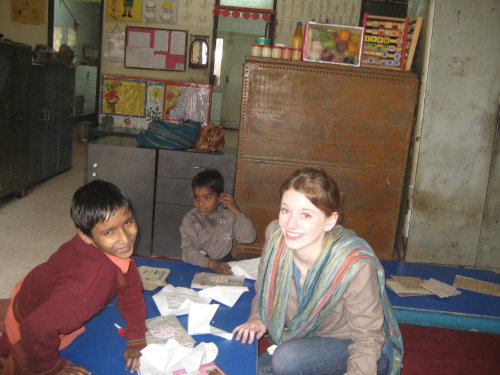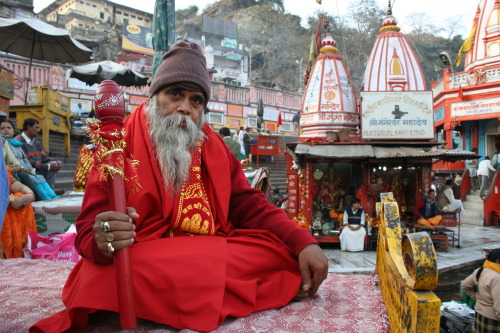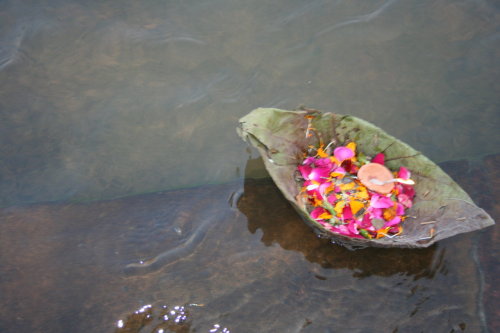After three consecutive weeks in Delhi, it was about time for a weekend adventure. Seven PM Friday night, Shanta, Sarah, and I boarded our first overnight train from Delhi to Udaipur. We had reserved seats in general admission 3-tier sleeper and like the AC-chair car, the name was a perfect description. Wall-like barriers created sections along the car, all open to a long corridor down the middle. Three levels of berths clung to the sides of each section with a total of nine beds in a nook. We settled down on one of the plastic hospital-blue mattresses and got ready for the twelve hour ride ahead of us. Men poured into the train car and made themselves at home on the other berths. They ate, belched, rubbed their feet, and answered cell phones. After a few hours, it was time for bed. Shanta and I climbed to our upper beds, cradled against the ceiling with steel to prevent us from rolling off. I slept with my backpack under my head but felt safe.
I opened my eyes as we pulled into the station Saturday morning. The train was mostly empty by now as Udaipur was the last stop on the line. We gathered our things and stepped out of the station into the fleet of eager rickshaw drivers. Picking one at random, we made our way to the hotel. Set back from the street by a circular brick driveway, the hotel looked like one big ornate mosaic doorway. Though hidden from view, it stretched white stone balconies and windows in every direction surrounded by a tiny but beautiful garden. The rooftop opened to an outdoor restaurant and glass-like swimming pool edged with elegant window ledges and pillows. Waiters eyed European tourists ready to provide every whim. Pigeons perched on the white stone lattice that topped the walls. Sarah, Shanta and I sprawled out on the pillows in one of the windows. I dozed off.
I woke up to the sun warming my shoulders and neck. I turned my head to look out of my little glass alcove framed by painted stone and watched a hawk circle lazily above the lake below. The lake was low and green moss and dirt formed a maze-like path above the water to the Lake Palace. In the distance a saffron flag blew in the breeze, silently marking the Sikh temple below. White stone temples rested on distant mountaintops giving the illusion of snow. The City Palace clung to a nearby hillside.
I can see how tourists come to India and never leave their hotels. Forty dollars a night can buy a romantic version of this third world democracy. From high on our rooftop haven, the jumble of angular brick buildings seemed so far below. For the first time on this trip, poverty abided by the notion “out of sight, out of mind.”
After hours of laziness, we left the hotel and entered the streets. Udaipur felt like a small town despite its actual size. Vendors made easy conversation and remembered us as we wandered to and fro, smiling each time we passed. Everyone seemed to know at least some English because of the tourism. Everywhere we looked, we found backpackers and hippies and yoga-lovers. Some vendors would try to guess our nationalities as we passed; “Brazil, Germany, and Australia!” We’d call back, “Wrong, it’s US and London!” It only took one day in Udaipur to have friends all over town.
The weekend slipped away far too quickly. Before we knew it, we were back in a rickshaw heading for the train station. This time, however, uncertainty kept us wide awake. When booking the return train, we had discovered that 3-tier sleeper was full. We had taken a gamble and booked three waitlisted first class tickets. Turns out we risked too much as only one of the three of us was allotted a seat on the train. On our way to the station, a bird pooped on me. Everyone assured me that was great luck though I felt having bird poop on the pants I’d be wearing for the next 24 hours was hardly providential. Still unsure of what to do about the train, we asked a snaky little man at the station who to talk to about the dilemma. He assured us (in broken English) that we were confused and all three of our seats were confirmed. He even showed us a list with all of our names printed on it and then attempted to sell us magazines. Taking his word, we all boarded the train and settled into a private cabin in first class. Again, forty dollars goes a long way in India. This time it bought us privacy… or so we thought. The car lurches and the station rolls away, concrete scenery giving way to trees and crossroads. A small man with round glasses checked our ticket and looked up sternly. “Only one berth. Two are waitlisted. Three more people come at 11:40pm.” Well dang. We exchange looks that somehow simultaneously express disappointment, frustration towards the snaky little magazine man, exhaustion, insanity, and humor but definitely not shock.
The ticket man leaves us pondering over the next five hours what exactly will happen when 11:40 rolls around and three more people join our cabin. Should they decide there are too many of us, two of us are doomed to sit in the corridor of the train for the whole night. Being a stow-away on an Indian train is mentally taxing so we eventually decide to nap in shifts. Every so often a random train attendant would pop his head in and say, “Three person! One person! WHY???” We would sleepily nod and mumble yes. “Three person, one person, why?” Yes, why was quite the question. Why were we confined to one bed? Because of waitlists. Why were we stow-aways? Because of a snaky little magazine man. Why weren’t we shocked? Because it’s India. Three person. One person. That’s why.
At 11:30pm, Sarah, Shanta, and I squeeze into our single bed just to test it out. By 11:40pm we’re all three anxiously sitting (to use Sarah’s term “like little gnomes”) on our bed eyeing the doorway awaiting our fate. The train stops and people bustle into the hallway. A well dressed woman enters the cabin holding a toddler, followed by her young daughter. Sarah begins to apologize for the crowd and explain our situation in hopes of striking a good chord with the decider of our fate. “Well that’s inconvenient for you” came the reply. Well dang. Another young girl (not related to the mother and daughter) timidly enters the cabin escorted by her father. The two young girls begin talking and before we knew it they had offered to share a bed, giving us a second berth. I guess bird poop isn’t that unfortunate after all.
Many somewhat sleepless hours later, we finally arrive back in Delhi on Monday morning with a couple hours to spare before work. For the past two weeks I’ve been working at a different cite with Mobile Creche. I had intended to switch to Mother Theresa’s but after a week at NBCC (the new site) I had fallen in love with the kids. I work with the older kids who’ve formed a rag-tag little gang. Meet the cast:
Shivam- 13 years old and small for his age, the ringleader, speaks the most English (which is very little)
Manoj- second in command, no English whatsoever, makes fun of me in Hindi all the time, trouble maker and a bit of a bully
Afsar- loves to dance, keeper of pens and other treasures, he tells me stories in Hindi
Rishi- sweetest boy in the world, his eyes light up when he learns something new, wears a tattered Brownies Girl Scout sweatshirt everyday
Ravi- somehow related to Shivam, wears a cross necklace, he doesn’t know English but always smiles and jokes with me
Sudita- Ravi or Shivam’s sister, stares at me and writes her name on my hand every day, speaks English fairly well
I was so tired by the time I got to NBCC this morning, I couldn’t even understand Shivam- granted he was in fact speaking a foreign language. “Didi nahin samjhi (you don’t understand)” he sighs. “I never do” I tell him. After sitting with the boys for a while, one of the teachers began some lesson in Hindi. Using the chalkboard he explained something with the help of a diagram. At first I thought it was weather and the diagram was of a cloud, however, the more he drew the more lost I got. Half asleep, I desperately tried to figure out what he could be teaching with a diagram that looked more and more like a potato riding a unicycle. A new teacher entered the room. She was beautifully dressed with more jewelry than most and I could tell by her thick red bangles she was recently married. She asked questions about me in Hindi and before long the class and several teachers were having an extended conversation about how much Hindi I knew, where I was from, and so on. Family members- these kids have your names and jobs memorized (“older brother’s name: Ben, student, not married!”). Finally Sunil arrived with the car and its back home for a long awaited nap filled with crazy dreams thanks to the powerful malaria pills (yes family, fear not, I went to the doctor and got malaria prevention pills because of next week’s trip to the tropical south of India). Just another weekend in Mother India.
 Today was my last day. As I walked up to the
school, Shivam appears from out of nowhere. He hasn’t been coming the past week
or so except to say hi so I was surprised he was here. Immediately he and Rajn
greet me and ask, “Didi, last day?” Yes I answer. “Ok, come.” They lead me into
the small dark classroom and Shivam pulls his drawing folder out of his
backpack. All the kids gather round as we flip through his tracings of Disney
movie characters. I mention something about Good Friday and Shivam looks up,
interested. “Christian Holy Day?” Again, I answer yes. He pulls out a blank
page and begins to draw. Slowly the figure on paper becomes recognizable: Santa
Claus. When I ask, he eagerly replies “yes, Santa- your god!” Somehow I’m not
at all surprised by the effects of commercial Christmas and capitalism, though
I had to laugh.
Today was my last day. As I walked up to the
school, Shivam appears from out of nowhere. He hasn’t been coming the past week
or so except to say hi so I was surprised he was here. Immediately he and Rajn
greet me and ask, “Didi, last day?” Yes I answer. “Ok, come.” They lead me into
the small dark classroom and Shivam pulls his drawing folder out of his
backpack. All the kids gather round as we flip through his tracings of Disney
movie characters. I mention something about Good Friday and Shivam looks up,
interested. “Christian Holy Day?” Again, I answer yes. He pulls out a blank
page and begins to draw. Slowly the figure on paper becomes recognizable: Santa
Claus. When I ask, he eagerly replies “yes, Santa- your god!” Somehow I’m not
at all surprised by the effects of commercial Christmas and capitalism, though
I had to laugh. 




